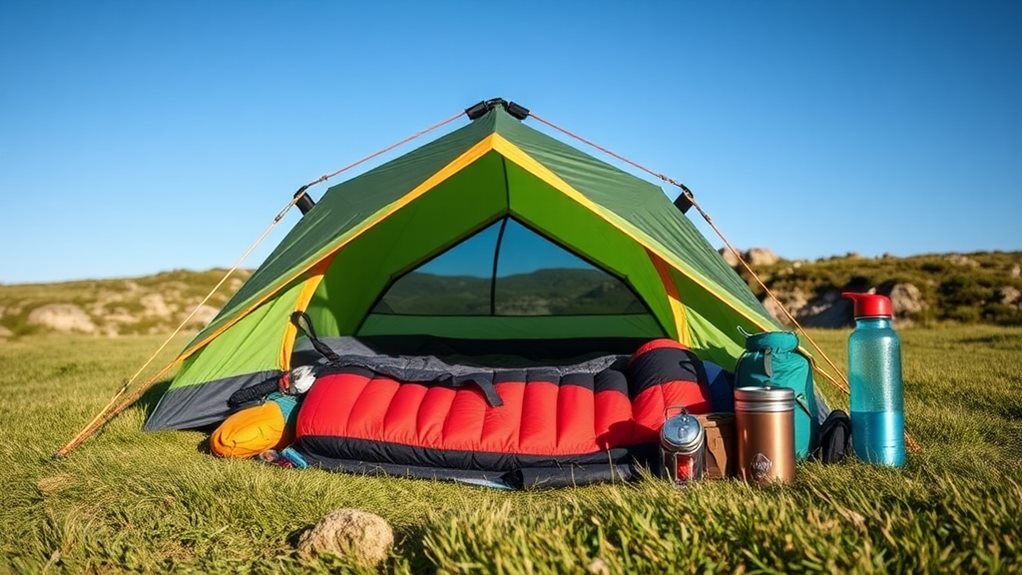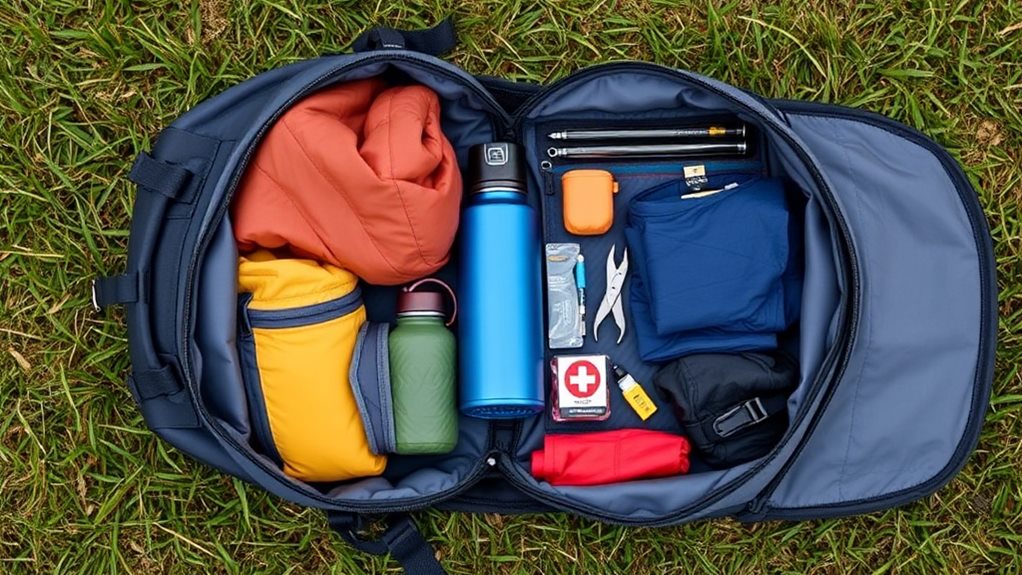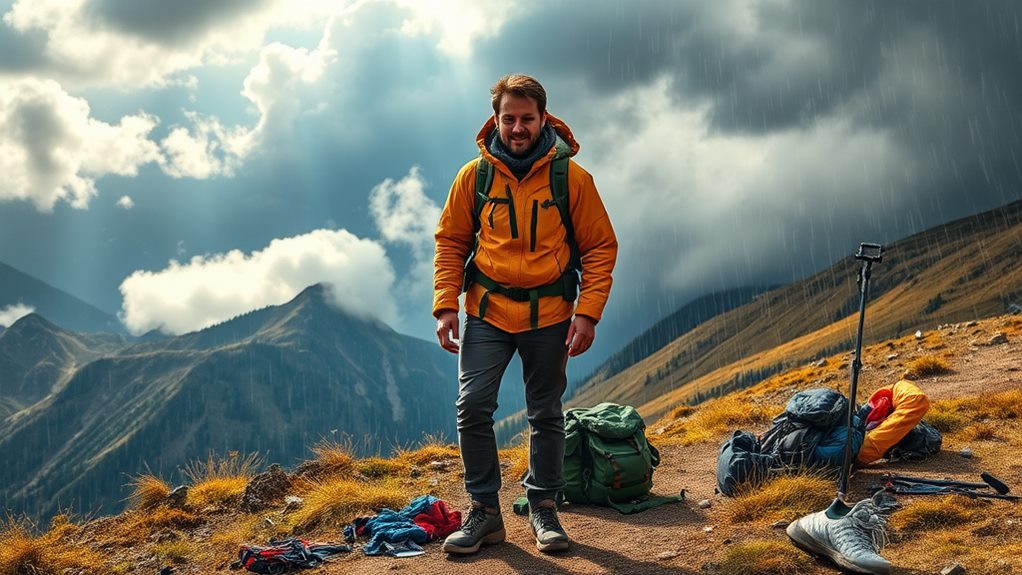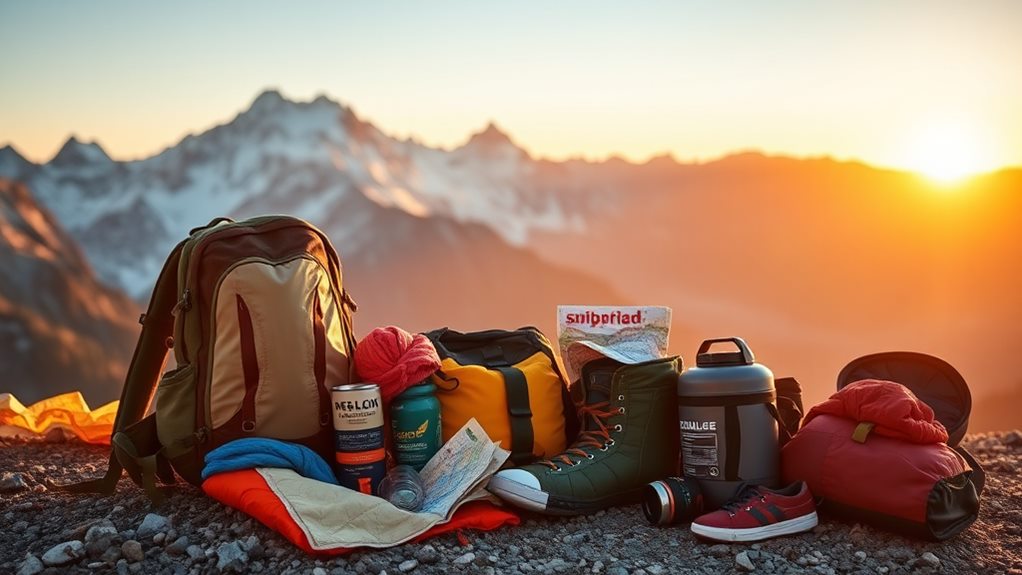When packing for a long-distance backpacking journey, start by choosing a durable backpack that fits snugly and distributes weight well. Opt for lightweight gear, utilizing nylon materials, and pack heavier items closer to your back. Organize your essentials with packing cubes, grouping similar items for easy access. Prioritize multi-use items like versatile clothing to keep your load light. Finally, plan for weather changes by packing moisture-wicking layers and a reliable rain jacket. With these tips, you'll set yourself up for a successful adventure. There's plenty more to explore about optimizing your packing strategy!
Key Takeaways
- Choose a durable, well-fitting backpack between 50-70 liters for optimal weight distribution during long hikes.
- Pack lightweight, multi-purpose gear and prioritize compact items to reduce overall weight.
- Organize your essentials using packing cubes and create a checklist for efficient packing.
- Prepare for weather changes by including moisture-wicking layers, a rain jacket, and extra warm clothing.
- Keep frequently used items easily accessible and store heavier gear close to your back for better balance.
Choose the Right Backpack

When it comes to long-distance backpacking, the right backpack can make all the difference in your comfort and enjoyment on the trail. You'll want to choose a backpack that fits your body snugly, distributing weight evenly and preventing strain on your back and shoulders.
The ideal backpack size depends on your journey; a pack between 50 to 70 liters typically suits multi-day hikes. Don't just focus on capacity, though—you should also consider how you'll meet your hydration needs on the trail, possibly with options like the best portable water filters for clean drinking water.
Take the time to try on various packs, adjust the straps, and pay attention to how it sits on your hips and back. A well-fitted pack feels like an extension of you, not a burden.
Comfort is essential. Look for padded shoulder straps and a supportive hip belt. These features help reduce fatigue, allowing you to enjoy those breathtaking views instead of focusing on discomfort.
You'll appreciate durability, too. A backpack made from high-quality materials withstands the wear and tear of the trail, ensuring it'll be by your side on many adventures to come.
Don't overlook ventilation and access points. A pack with a breathable back panel keeps you cooler on hot days, while multiple pockets allow for easy access to your gear.
Remember, the right backpack isn't just about practicality; it's about creating lasting memories with fellow hikers. When you're comfortable and well-equipped, you're more likely to bond over shared experiences, forging connections that make every journey special.
Pack Lightweight Gear

Finding the right backpack is just the first step; packing lightweight gear is fundamental to a successful long-distance backpacking trip. When you're out on the trail, every ounce matters.
Opt for gear made from lightweight materials like nylon or polyester, which can save you significant weight without compromising durability. Consider using packing cubes to maximize your organization and efficiency—these 5 best packing cubes can help keep your gear neatly sorted and accessible.
Think about your essentials—sleeping bags, tents, and cooking equipment. Invest in compact versions that serve multiple purposes. For example, a cooking pot can double as a bowl.
Don't forget about gear maintenance. Keeping your equipment in top shape not only prolongs its life but also ensures it performs well when you need it most. Regularly check for wear and tear, and clean your gear to avoid unnecessary weight from dirt and grime. A well-maintained item is lighter and more efficient, making your journey smoother.
Weight distribution is critical, too. Pack heavier items close to your back and higher up in your backpack. This positioning improves balance, making it easier to navigate those challenging trails. If your gear shifts during your hike, it can lead to discomfort and fatigue. By guaranteeing a solid weight distribution, you'll feel more stable and energetic, allowing you to fully enjoy the beauty around you.
Ultimately, choosing lightweight gear and maintaining it well is about creating a fulfilling experience on the trail. You're not just carrying a pack; you're carrying your sense of adventure and connection to nature. So pack wisely, and embrace the journey ahead!
Organize Your Essentials

Organizing your essentials is vital for a smooth long-distance backpacking journey. When you're out exploring the wilderness, the last thing you want is to rummage through your pack for an important item. By streamlining your organization, you can save time and energy, allowing you to fully enjoy the adventure ahead. Consider the comfort of your travel gear as well, just like choosing the right pet carrier backpacks can enhance your pet's travel experience.
Start by investing in packing cubes. These handy compartments help you keep different categories of gear together, making it easy to find what you need without creating chaos. Use checklists and labels to clearly mark what each cube contains—this way, you won't accidentally grab your cooking gear when you're looking for a rain jacket. Here are some tips to help you get started:
- Group similar items: Keep your clothing, cooking supplies, and toiletries together.
- Use color coding: Assign colors for different categories of gear to make identification quicker.
- Create a packing checklist: Write down everything you plan to bring, and check items off as you pack.
- Label your cubes: Clearly mark each packing cube to avoid confusion on the trail.
- Consider accessibility: Place frequently used items at the top of your pack for easy access.
Prioritize Multi-Use Items

In long-distance backpacking, prioritizing versatile items can significantly lighten your load and enhance your experience. When you embrace adaptable clothing options, you'll find yourself packing less while still staying comfortable and ready for any adventure.
For instance, a lightweight jacket that functions as both a raincoat and a windbreaker can save you the trouble of carrying multiple layers. Opt for pants that zip off into shorts, giving you two choices in one garment. These selections not only reduce the weight of your pack but also provide you with the flexibility needed for changing conditions.
Space-saving strategies also play an essential role here. Think about packing items that can serve dual purposes. A compact sleeping bag that doubles as a travel pillow can save precious space in your backpack. You might also consider a cooking pot that can act as a food storage container. Each multi-use item you include means more room for essentials or comforts that enhance your journey.
As you plan your packing list, focus on what you truly need and how each item can serve multiple functions. This approach fosters a sense of freedom and connection with your surroundings, allowing you to fully immerse yourself in the experience. By prioritizing versatile items, you not only lighten your load but also embrace a minimalist mindset that enhances the joy of exploration.
Plan for Weather Variability

Weather can be unpredictable, and being prepared for its variability is essential for any long-distance backpacking journey. You never know when the sun might hide behind clouds or when unexpected rain might soak your plans. That's why incorporating smart layering strategies and considering climate conditions are critical. By doing so, you'll stay comfortable and dry, no matter what Mother Nature throws your way.
Here are some necessary packing tips to help you navigate weather fluctuations:
- Base Layers: Opt for moisture-wicking fabrics to keep sweat away from your skin.
- Insulating Mid Layers: Bring a lightweight fleece or down jacket for warmth during chilly evenings.
- Waterproof Outer Layer: A reliable rain jacket is a must-have to shield you from sudden downpours.
- Emergency Supplies: Always pack a small first-aid kit and extra food in case you find yourself in a tight spot.
- Packing Backups: Consider packing an extra pair of socks and gloves, so you can stay dry and warm.
With these items, you'll be ready to face any climate considerations. Remember, layering is key; it allows you to adjust your clothing to suit changing temperatures. By planning for weather variability and being prepared with the right gear, you'll enhance your backpacking experience and foster a sense of security within the group.
Embrace the journey, rain or shine!
Frequently Asked Questions
What Are the Best Shoes for Long Distance Backpacking?
When you're choosing the best shoes for long-distance backpacking, proper footwear is key. Look for lightweight, breathable hiking boots or trail runners that offer good support and traction.
Don't forget about sock selection; moisture-wicking, cushioned socks can prevent blisters and enhance comfort.
How Do I Stay Safe While Backpacking Alone?
When you're wandering the wilds alone, safety is essential. Start by securing emergency communication; keep a charged phone and a portable charger nearby.
Study self-defense techniques to empower yourself against potential threats. Stay aware of your surroundings, and trust your instincts—if something feels off, it probably is.
Share your itinerary with someone, and check in regularly. By embracing these safety strategies, you enhance your experience while feeling confident and connected.
Should I Bring a First Aid Kit?
Absolutely, you should bring a first aid kit. It's your safety net in emergency situations, and you'll feel more confident knowing you're prepared. Stock it with essential medical supplies like band-aids, antiseptic wipes, and pain relievers.
Picture yourself hiking with peace of mind, ready to tackle any minor injuries that might arise. It's not just about the journey; it's about feeling secure and connected to the outdoors, knowing you've got what you need.
How Can I Keep My Valuables Secure?
Did you know that over 60% of travelers report having valuables stolen while on the road? To keep your belongings secure, use bags with hidden pockets and lockable zippers. Incorporate security measures like tracking devices to monitor your items. Consider wearing a money belt under your clothes for cash and important documents. By being proactive about your valuables, you can focus on enjoying your journey without the constant worry of theft.
What Snacks Are Best for Energy During Hikes?
When you're hiking, you need snacks that fuel your energy. Go for trail mix with nuts, dried fruits, and seeds to maintain nutritional balance.
Energy bars packed with whole grains and protein are great too.
Don't forget hydration options like electrolyte drinks or coconut water to keep you refreshed.
These choices not only sustain you but also make you feel connected to nature, enhancing your overall hiking experience.
Enjoy every bite and sip!
Conclusion
As you hit the trail, remember that every ounce counts, yet comfort is key. Balancing lightweight gear with the essentials means you're free to explore without the burden of excess. Organizing your pack keeps everything at your fingertips, while multi-use items save space and weight. Embrace the unpredictability of weather, and you'll be ready for anything. With these packing tips, you're not just prepared; you're empowered to enjoy every breathtaking moment of your long-distance adventure.

